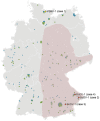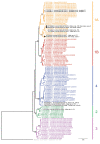Active Case Finding of Current Bornavirus Infections in Human Encephalitis Cases of Unknown Etiology, Germany, 2018-2020
- PMID: 33900167
- PMCID: PMC8084505
- DOI: 10.3201/eid2705.204490
Active Case Finding of Current Bornavirus Infections in Human Encephalitis Cases of Unknown Etiology, Germany, 2018-2020
Abstract
Human bornavirus encephalitis is a severe and often fatal infection caused by variegated squirrel bornavirus 1 (VSBV-1) and Borna disease virus 1 (BoDV-1). We conducted a prospective study of bornavirus etiology of encephalitis cases in Germany during 2018-2020 by using a serologic testing scheme applied along proposed graded case definitions for VSBV-1, BoDV-1, and unspecified bornavirus encephalitis. Of 103 encephalitis cases of unknown etiology, 4 bornavirus infections were detected serologically. One chronic case was caused by VSBV-1 after occupational-related contact of a person with exotic squirrels, and 3 acute cases were caused by BoDV-1 in virus-endemic areas. All 4 case-patients died. Bornavirus etiology could be confirmed by molecular methods. Serologic testing for these cases was virus specific, discriminatory, and a practical diagnostic option for living patients if no brain tissue samples are available. This testing should be guided by clinical and epidemiologic suspicions, such as residence in virus-endemic areas and animal exposure.
Keywords: BoDV-1; Germany; VSBV-1; active case finding; bornavirus; bornavirus disease virus 1; case definition; epidemiology; etiology; human encephalitis; infections; meningitis/encephalitis; serologic analysis; variegated squirrel bornavirus 1; viruses; zoonoses.
Figures




Comment in
-
Fatal encephalitis and Borna Disease Virus-1 seropositivity in two kidney-transplant patients living in the same nonendemic area.Transpl Infect Dis. 2021 Dec;23(6):e13734. doi: 10.1111/tid.13734. Epub 2021 Dec 14. Transpl Infect Dis. 2021. PMID: 34549497 No abstract available.
References
Publication types
MeSH terms
Substances
LinkOut - more resources
Full Text Sources
Medical

